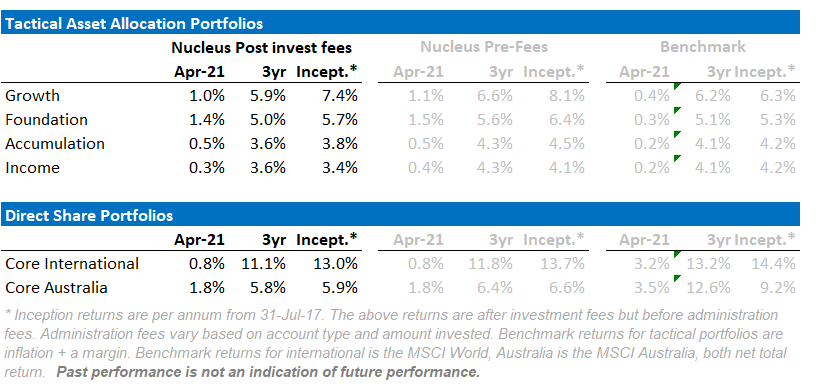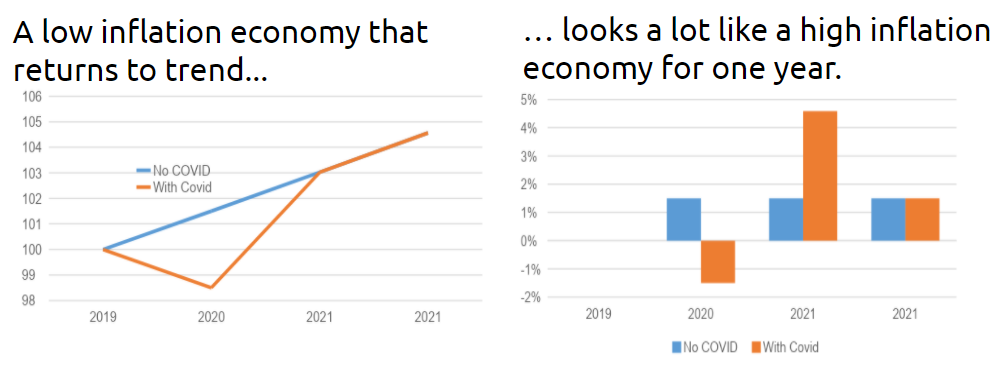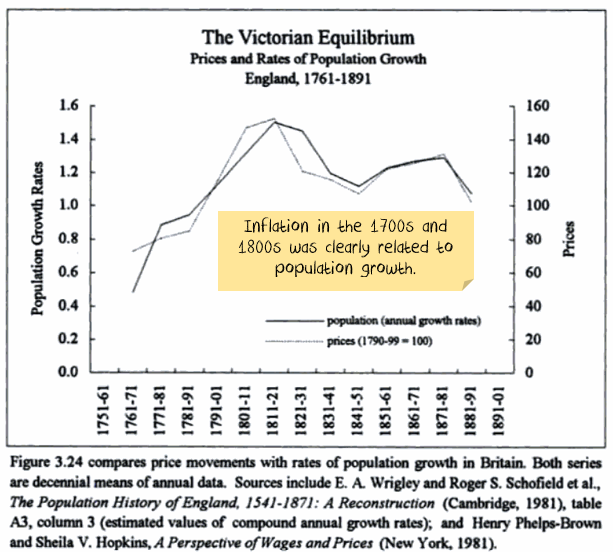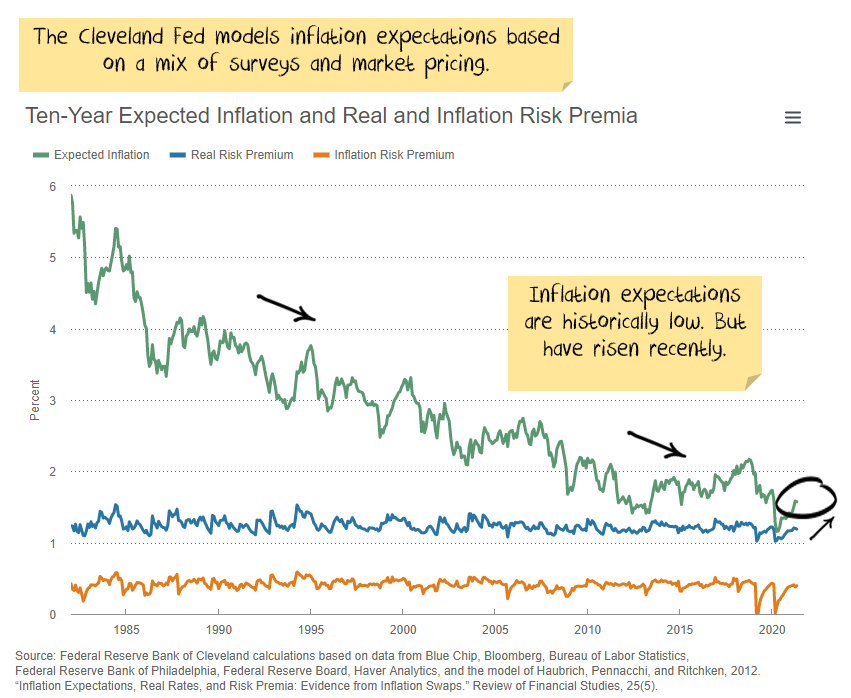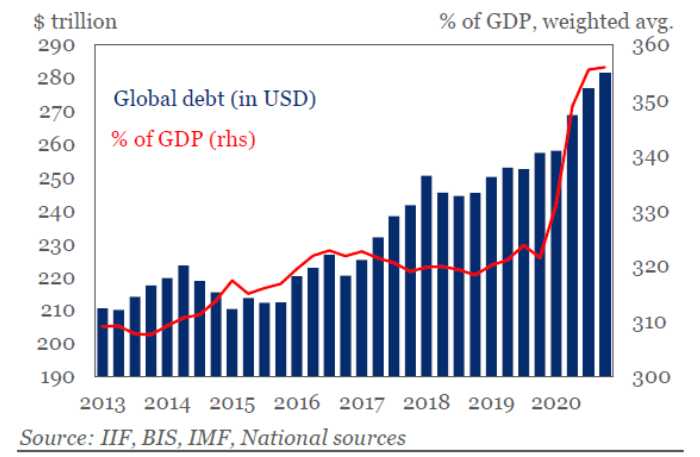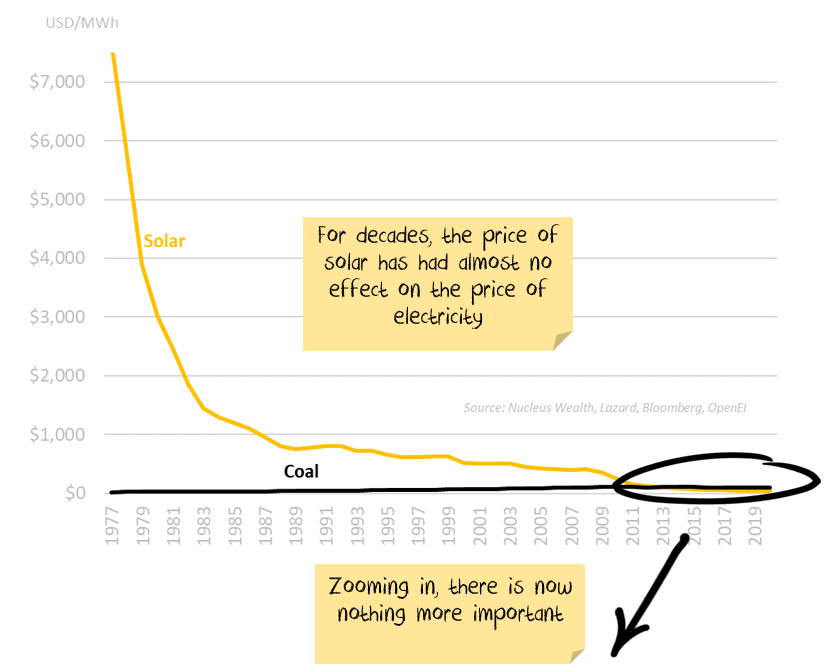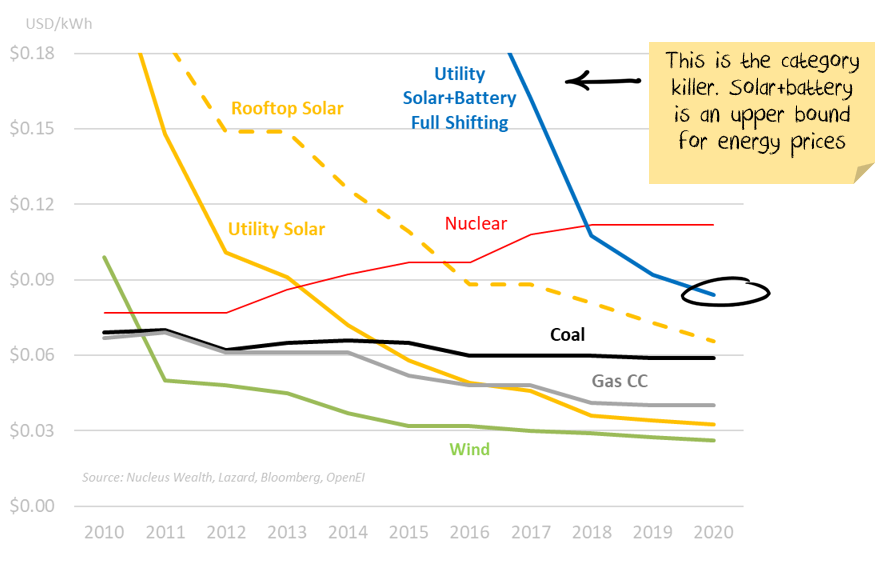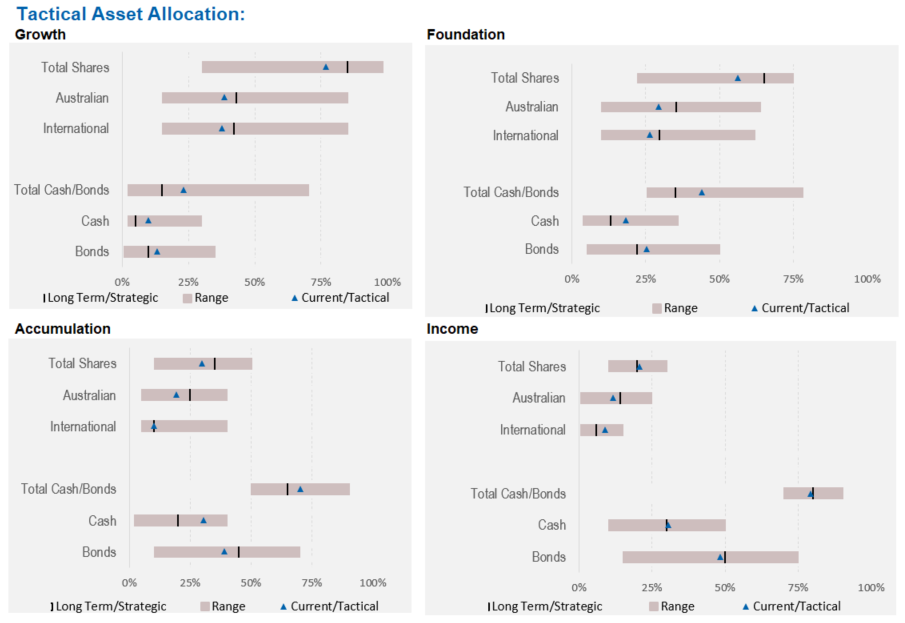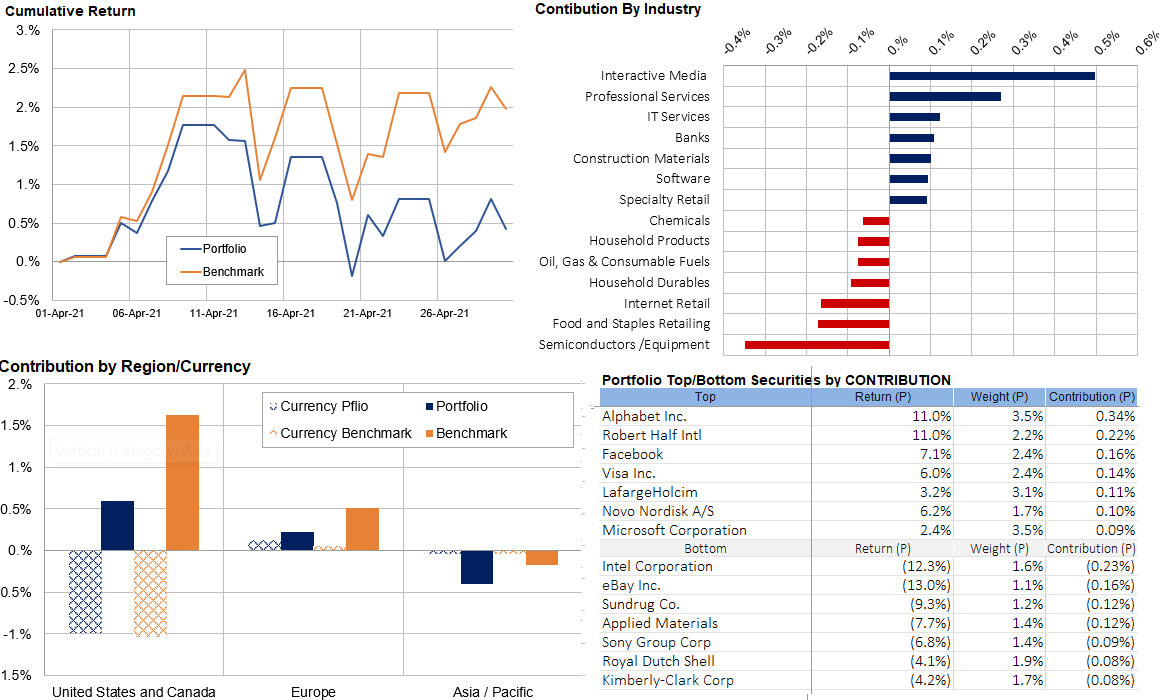April continued the March boom, with the US leading the way, buoyed by a swift vaccine roll-out and fiscal stimulus measures. Investor sentiment was supported by the combined economic and policy backdrops, but also a robust US earnings season.
Our asset allocation portfolios all posted positive returns for the month, and continue to deliver significantly lower volatility than the market.
More importantly, it was a reversal month. Value stocks performed strongly in March (and again so far in May) – and our portfolios are leveraged to that trade. The reversal in April meant that we did not rise as quickly as the market, but our underperformance has been erased so far in May as markets returned to the value trade.
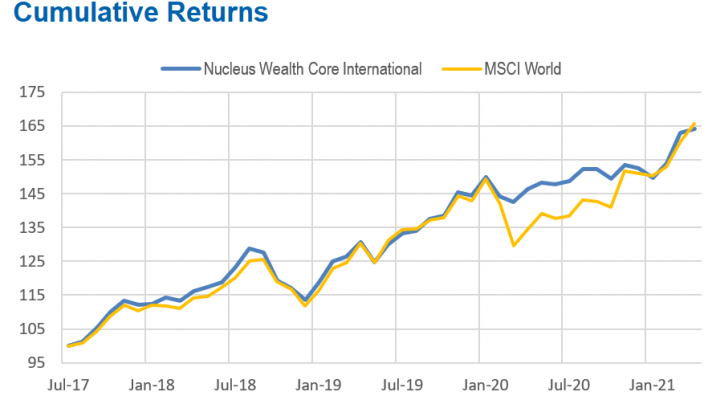
Inflation measures hit the front pages
We have been warning for months that markets will get carried away with extrapolating short term inflation long into the future. This month we saw high inflation prints in the US and we expect inflation will stay high in the coming months. But most of the inflation is either in the supply chain or comes from low base effects, both of which will pass.
Inflation is not well understood.
Inflation is not well understood. Most central banks have been trying to create inflation for the last decade. And failing. The Bank of Japan? 30 years.
In 2010, many prominent economists were so sure hyperinflation was coming that they wrote an open warning to the then head of the US Federal Reserve. No inflation.
This isn’t to say we know nothing about inflation. But it does mean that we need to approach inflation forecasts with skepticism and keep an open mind on outcomes.
A brief history of inflation
The olden days
Pre-1900, inflationary bouts were common. They tended to coincide with either population growth, famines, war or monetary debasement.
Today’s economies are different. The factors that cause inflation in agricultural societies are not the same as in a modern economy.
Population growth will still affect inflation, but population growth is very low relative to historical levels.
Stagflation era
The world struggled with both high inflation and high unemployment for most of the 1970s and 1980s. This is the scenario that technocrats are looking to avoid.
It is worth noting three other important factors:
- Monetary system: In 1974, the world monetary system changed significantly. The US severed their link with gold, meaning that we were reliant on the will of politicians to keep inflation in check. That didn’t work.
- Oil prices: The rise of the OPEC oil cartel saw a significant increase in oil prices. The flow-on effect of increased transport costs bounced from one industry to the next, exacerbating high inflation.
- Big governments: Many industries were government-owned. Telecommunications, power, airports, infrastructure. Many were not particularly efficient.
High inflation becomes the norm in the 1980s.
Inflation expectations became entrenched. Employees demanded continual wage rises to offset the effect of the higher expected inflation.
Companies had to raise prices to keep profitable. Meaning employees needed a pay raise. Rinse. Repeat.
The pendulum swings to the other side
Stagflation was cured in the 1980s. The narrative is inflation was solved by the US central bank, which raised interest rates high enough to stamp inflation out. i.e. the central bank was prepared to cause a recession to “anchor” inflation expectations.
Just as importantly, new rules were enacted to “ensure” inflation wouldn’t return:
- Monetary System: Independence from political intervention for central banks, inflation targets, various rules on government money printing.
- Oil Prices: The best solution to high commodity prices is high commodity prices. A wave of investment and increased supply meant oil prices stopped rising.
- Deregulation: A range of industries changed from public to private ownership, lowering costs.
Arguably, the pendulum has swung too far. The steps taken to prevent inflation have entrenched disinflation.
Now, low inflation becomes the norm.
Low inflation expectations became entrenched. Employees stopped demanding continual wage rises. Unionisation rates plummeted.
Additionally, China entered the World Trade Organisation and started routinely exporting deflation in the form of lower prices for manufactured goods.
Debt
Debt is a two-edged sword when it comes to inflation. Increasing private debt levels can drive inflation higher while the debt is accumulating.
However, unless private incomes also increase, high debt levels serve to decrease demand.
i.e. if the debt is created for productive assets like buying new businesses or infrastructure, it can quickly pay for itself.
Suppose the debt has been accumulated in non-productive assets like bidding house prices higher. In that case, there is more likelihood that it will slow inflation.
Debt levels are high. Wage growth is low.
Technological disruption
Technology is inherently deflationary. Incremental improvements are at the heart of capitalism. In recent decades the internet disintermediated entire industries, reducing costs, increasing competition and lowering inflation.
Energy
In the next few decades, power grids will either evolve or collapse. The age of centralised energy is all but over. Ahead lies a radical evolution to the decentralised and local. Moreover, as it is completed, energy costs will continue to decline every year, sourced from sun and wind every day and stored in little boxes of chemicals.
The productivity and income gains implicit in this are immense. Every bit as large as the steam and oil revolutions before it.
Robotics
Any and every repetitive function in the economy is going to be inhabited by a robot. Everything from manufacturing to driving is in the cross-hairs.
Technological advancement will destroy jobs. But the productivity gains that come with it will lift incomes for both capital and labour. This will create demand and investment in new and more efficient segments.
There will be a major question about the disruption of job losses. Done well, part of the productivity gains will be temporarily used to transition those who have lost jobs into the new economy. Done poorly, soaring unemployment will create political chaos.
Either way, the forces are deflationary.
The road to lasting, rather than transient inflation
Inflation is too much money chasing too little goods or services. Short term issues like weather or supply chain bottlenecks do not create lasting inflation.
What can create lasting inflation?
- Demographic changes can create shortages and inflation. But population growth is low.
- Wage growth creates extra demand and is the best source of lasting inflation. In many developed countries, manufacturing has shrunk as a proportion of the economy by a third since the 1980s. This puts even more focus on wages, as wages are the largest cost for service companies. But wage growth is as low as it has ever been in many countries. Wage growth will likely improve. But it is a long (long) way from being a problem.
- Energy. When oil prices rose by a factor greater than 10x from 1970 to 1980, this added persistently to supply costs. The levels were so high that companies had to pass on the costs. At the moment, many oil-producing countries are artificially reducing supply to keep oil prices high. As demand picks up this supply will return, and the higher prices have attracted commercial operators (US shale gas in particular) to expand supply. While electric vehicles are not yet cost-competitive for the average vehicle, battery costs continue to fall. That will limit how much the oil price can affect the broader economy over time. Just as importantly, in the 1970s and 1980s, weak consumer demand was not an issue. In the 2020s, it is. Higher oil prices act as an additional tax on consumers.
- Food. This is a bigger issue for emerging markets than for developed markets. Food prices have been deflationary over the long term.
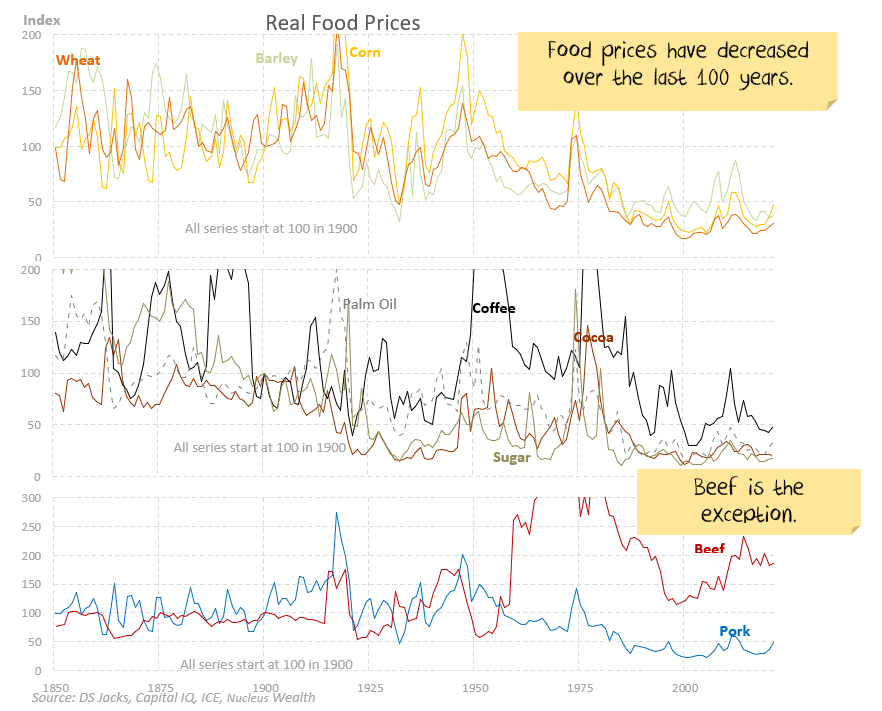
Can there be a short term spike in food prices? Yes, but in developed countries, food is a low of overall prices. And much of the cost of food is in the preparation costs, which is about wage inflation.
- Government fiscal policy that keeps creating demand even when the economy is at full capacity will create lasting inflation. Maybe this will be a problem. But capacity utilisation is a long way below prior levels. If this happens, it will be a number of years in the making.
- Inflation in “sticky” priced items like rent, healthcare and other items with generally stable prices are likely to indicate lasting inflation. The inflation we are seeing at the moment is in “flexibly” priced items like fuel and food.

- Permanent supply cost issues. These are the most difficult to get a read on. Clearly, there are short term supply issues in items like semiconductors, cars and building products adding to inflation. Additionally, companies have been trying to expand their low inventory levels to cater for potential future disruptions. There are anecdotal reports of companies stockpiling to ensure supply. All of these are, at best, transitory.
Inflation is not a “one-period” issue. For inflation to persist, the supply issues will need to be maintained. And maybe even get worse every year. This is not a likely outcome.
The worst scenario for inflation?
- Buyers increase demand now to fill inventories and prices jump.
- Suppliers, encouraged by high prices, add more capacity.
- Buyers then drop back to normal demand levels once inventories are full.
- Suppliers capacity comes online just as buyers have filled inventories. Suppliers then need to cut prices significantly to offload their increased production. Prices fall below the original levels.
- A change in inflation expectations. At the moment, inflation expectations are anchored. There have been some recent surveys suggesting a jump in expectations.
Net Effect
We have taken a nuanced investment strategy for the last few months. We don’t believe the inflation will be real. But we do believe the market will treat the inflation as real.
As we predicted, it is easy for the market to believe rates are on hold forever when inflation is 1%. It is another thing when inflation prints 4%. Even if the 4% is a temporary number.
The inflation mirage has not finished. There are at least a few more months before inflation will fall. And the inflationistas are out in force.
This means the trick is maintaining enough inflation protection to hedge against continued inflation concerns, while we wait for the right time to take the opposite stance. The benefit is that if signs emerge that inflation will continue then there will be little lost in reversing course.
Asset Allocation
As the switch into value continues, the key for us is maintaining protection. Markets continue to be expensive and while the grind higher is likely, there are also considerable downside risks.
Performance Detail
The equity market continued to climb over April, building on the March gains. Our Core portfolios produced gains but underperformed their respective indices, as some of our value plays took a breather, and growth stocks posted strong gains. We refrained from any major stock changes this month.
Core International Performance
Our international portfolio saw a 0.8% increase over April. Some disappointing earnings results from Ebay and Intel were offset by a strong performance of Internet stocks. The currency effect was the opposite of March detracting from US returns but helping European performance.
Core Australia Performance
The Core Australian portfolio underperformed the index this month as travel stocks faltered and our new USD earners suffered due to the currency headwinds.
Damien Klassen is Head of Investments at Nucleus Wealth.
Follow @DamienKlassen on Twitter or Linked In
The information on this blog contains general information and does not take into account your personal objectives, financial situation or needs. Past performance is not an indication of future performance. Damien Klassen is an authorised representative of Nucleus Wealth Management, a Corporate Authorised Representative of Nucleus Advice Pty Ltd – AFSL 515796.

